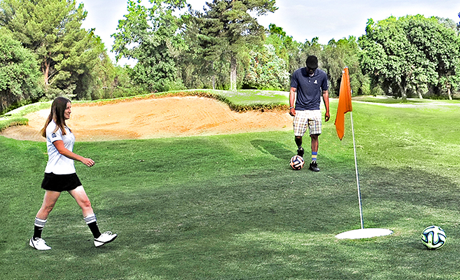
One of the exciting aspects of FootGolf is its potential to bring a whole new demographic of players out to the golf course. Some of these players may never have played golf before, let alone been out on an actual golf course. So if you’re new to the game or know someone who is, remind them to care for the course! Golf courses, just like soccer pitches, can be affected by the wear and tear of constant play. This is one of the reasons soccer cleats are banned from the sport of FootGolf. And just as golf has rules about caring for the course after a golfer swings a club or hits the ball, there are ways FootGolfers can also care for the course to help keep it in its best shape for golfers and FootGolf players alike.
Bunkers
If you happen to find yourself in a bunker (trust us, it happens to us all), remember – you should line yourself up as closely as possible to your ball before walking into the bunker, so you don’t make any unnecessary tracks while inside. Then when you kick your ball, try not to dig up too much sand and leave a large intent in the sand. And before leaving the bunker, players should carefully fill up and smooth over any holes or footprints made. If you see a footprint or hole left from someone else, please fix it as well! If a rake is in reasonable proximity, you should use it for this purpose, and remember – rake your footprints away as you leave!
Repair Divots, Ball Marks, and Shoe Damage
While on the fairways, on the green, and even in the rough, you should always carefully repair any divot holes or indentations you make with your shoe, and any damage made to the putting green from the impact of the ball. As you play, if you see any other divots or ball-impact spots that have been left behind, if it’s convenient and quick, please repair one + your own. This is a good rule golfers use and FootGolf players should follow as well.
On completion of a hole (by all players in your party), any noticeable damage to the putting green caused by shoes, balls, or the flagstick should also be repaired before moving on.
Golf Carts
Golf carts can wreak havoc on golf course grass, so remember to adhere to all local notices regulating the movement of the carts. If a 90-degree rule is in effect, you must line your golf cart up with the ball before driving over to it. Cart paths only means just that – stay on the path! These rules are not just meant to get you up and walking more, but oftentimes they are put in place to help the grass recover or grow. Tire tracks and ripped up turf can cause long-term damage to a course, so be aware of your golf cart, your feet (dragging your shoe outside the cart as you drive can pull up the grass!), and jumping in and out of the cart as you play.
Preventing Unnecessary Damage
While FootGolf should be fun, full of laughter and socializing, please remember to always be respectful of the golf course (and other golfers!) You should avoid causing damage to the course by removing or creating divots – whether it’s because you’re angry and kick the ground, or you Charlie Brown a drive on the tee box, or you just a bit excited. All players in your party should ensure that no damage is done to the putting green when dropping the flagstick or waiting your turn to putt, etc.
To avoid damaging the hole itself, players should not stand too close to the hole edge (shoes can bend the green down into the hole), and you should take care while returning the flagstick and retrieving holed balls. Remember, the flagstick needs to be properly replaced in the hole before you leave the putting green.
Learning to care for the FootGolf course and following these simple, considerate rules of play can help keep the course in shape and let everyone continue to enjoy the great game of FootGolf! How do you care for the course? Let us know in the comments section!



